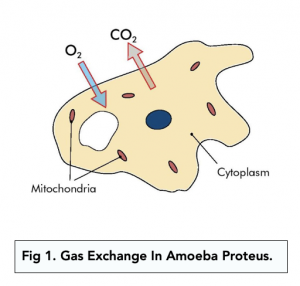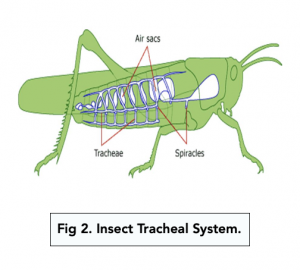Gas Exchange in Insects (A-level Biology)
Gas Exchanges in Unicellular Organisms:
- In unicellular organisms, gas exchanges occur via the cell membrane. Oxygen and carbon dioxide are small enough to pass through cell membranes without any trouble.
- Gas exchanges across membranes are carried out through simple diffusion. Oxygen, which is in higher concentrations in the environment, diffuses across the membrane into the cell. Carbon dioxide, which is in higher concentrations in the cell, diffuses into the environment. Both gases diffuse across a concentration gradient.
- Amoeba proteus is an example. Amoeba proteus is a single celled organism which uses this system for gas exchange. Try to remember this organism in case you are asked to provide an example of a unicellular organism which uses its cell membrane to carry out gas exchange.

Gas Exchanges in Insects
- Insects don’t have a transport system. As oxygen needs to be transported directly to tissues which are undergoing respiration, they have a specialised gas exchange system.
- Most insects are land organisms with a tough exoskeleton. Insects have an exoskeleton, which helps to prevent the insects from losing water from their bodies, as well as protecting them from their environment.
- Exoskeletons are too thick for gas exchange. Because of their structure, exoskeletons are usually too thick to allow for simple diffusion to occur for gas exchanges.
- Gas exchanges in insects occur via the tracheal system. Gas exchange occurs via a special organ system known as the tracheal system. It is a very simple respiratory system found in many insects.
- Mechanical ventilation is used by some active insects. Occasionally, ventilation of active insect’s respiratory systems can happen via mechanical ventilation (pumping the abdomen) or air reserves, sometimes both simultaneously.
- There are multiple ways of diffusing gases. Diffusion is used in the trachea, whereas mass transport is used as a result of muscle contraction, and volume changes in the tracheoles.
Functions of Tracheal System Structures
- Spiracles – tiny holes able to let air enter the body and prevent water loss. They are controlled by specialised muscles to be opened or closed. Spiracles are used to pass air to the trachea.
- Trachea – a tube lined with chitin, which branches into smaller tubes known as tracheoles.
- Tracheoles – they deliver oxygen to the cells and tissues of the insect.
- Chitin – impermeable rings which work to stop structures collapsing. As they are impermeable, it stops diffusion.
- Lactic acid – oxygen dissolves into this fluid, where it reaches individual cells to start simple diffusion. The carbon dioxide from this process gets released into the environment through the spiracles.
Pathway of Oxygen in Tracheal System
- Air enters into the body of insects through spiracles.
- Spiracles transfer the air to thin tubes called the tracheae.
- The tracheal system contains a special fluid for carrying oxygen.
Sometimes, water builds up at the bottom of the tracheoles, causing slower diffusion. To remove this, lactic acid begins to build up in the cells, decreasing their water potential, where water can move back into the cells.

Gas exchange in insects refers to the process of exchanging oxygen and carbon dioxide between the insect’s body and the environment.
Insects exchange gases through a system of tiny tubes called tracheae. Oxygen enters the tracheae and diffuses into the insect’s body, while carbon dioxide produced by cellular respiration diffuses out of the insect’s body and into the tracheae.
The tracheal system is a network of tiny tubes that run throughout the insect’s body, providing a direct connection to the environment. The tracheal system enables the exchange of gases between the insect’s body and the environment.
Unlike mammals, which have a specialized respiratory system with lungs and airways, insects have a simple tracheal system that provides a direct connection to the environment. The tracheal system allows for efficient gas exchange, but it is not as complex as the respiratory system in mammals.
The structure of the tracheal system, with its small diameter and large surface area, enables efficient gas exchange. The tracheae are lined with a permeable cuticle that allows gases to diffuse into and out of the insect’s body.
Spiracles are the openings to the tracheal system on the surface of an insect’s body. The spiracles can open and close, allowing the insect to regulate the flow of air into the tracheal system. This enables the insect to control the rate of gas exchange and maintain the balance of oxygen and carbon dioxide in its body.
Yes, changes in the gas exchange system can have a significant impact on the survival of an insect. The exchange of gases is essential for the insect’s metabolic processes, and disruptions in gas exchange can lead to reduced oxygen levels and increased carbon dioxide levels, potentially resulting in death.






Still got a question? Leave a comment
Leave a comment